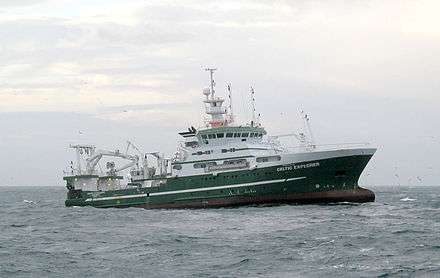Seaweed farming
Seaweed farming or kelp farming is the practice of cultivating and harvesting seaweed. In its simplest form, it consists of the management of naturally found batches. In its most advanced form, it consists of fully controlling the life cycle of the algae.

The main food species grown by aquaculture in Japan, China and Korea include Gelidium, Pterocladia,[1] Porphyra,[2] and Laminaria.[3] Seaweed farming has frequently been developed as an alternative to improve economic conditions and to reduce fishing pressure and overexploited fisheries. Seaweeds have been harvested throughout the world as a food source as well as an export commodity for production of agar and carrageenan products.[4]
Global production of farmed aquatic plants, overwhelmingly dominated by seaweeds, grew in output volume from 13.5 million tonnes in 1995 to just over 30 million tonnes in 2016.[5] As of 2014, seaweed was 27% of all marine aquaculture.[6] Seaweed farming is a carbon negative crop, with a high potential for climate change mitigation .[6] The IPCC Special Report on the Ocean and Cryosphere in a Changing Climate recommends "further research attention" as a mitigation tactic.[7]
History
Cultivation of gim (laver) in Korea is reported in books from the 15th century, such as Revised and Augmented Survey of the Geography of Korea and Geography of Gyeongsang Province.[8][9]
Seaweed farming began in Japan as early as 1670 in Tokyo Bay.[2] In autumn of each year, farmers would throw bamboo branches into shallow, muddy water, where the spores of the seaweed would collect. A few weeks later these branches would be moved to a river estuary. The nutrients from the river would help the seaweed to grow.[2]
In the 1940s, the Japanese improved this method by placing nets of synthetic material tied to bamboo poles. This effectively doubled the production.[2] A cheaper variant of this method is called the hibi method — simple ropes stretched between bamboo poles. In the early 1970s, there was a recognized demand for seaweed and seaweed products, outstripping supply, and cultivation was viewed as the best means to increase productions.[10]
The practice of seaweed farming has long since spread beyond Japan. In 1997, it was estimated that 40,000 people in the Philippines made their living through seaweed farming.[11] Cultivation is also common in all of southeast Asia, Canada, Great Britain, Spain, and the United States.[1]
In the 2000s, Seaweed farming has been getting increasing attention due to its potential for mitigating both climate change and other environmental issues, such as agricultural runoff.[12][13] Seaweed farming can be mixed with other aquaculture, such as shellfish, to improve water bodies, such as in the practices developed by American non-profit GreenWave.[12] The IPCC Special Report on the Ocean and Cryosphere in a Changing Climate recommends "further research attention" as a mitigation tactic.[7]
Methods
The earliest seaweed farming guides in the Philippines recommended the cultivation of Laminaria seaweed and reef flats at approximately one meter's depth at low tide. They also recommended cutting off seagrasses and removing sea urchins before farm construction. Seedlings are then tied to monofilament lines and strung between mangrove stakes pounded into the substrate. This off-bottom method is still one of the primary methods used today.[14]
There are new long-line cultivation methods that can be used in deeper water approximately 7 meters in depth. They use floating cultivation lines anchored to the bottom and are the primary methods used in the villages of North Sulawesi, Indonesia.[15][16] Species cultured by long-line include those of the genera Saccharina, Undaria, Eucheuma, Kappaphycus, and Gracilaria.[17]
Cultivation of seaweed in Asia is a relatively low-technology business with a high labor requirement. There have been many attempts in various countries to introduce high technology to cultivate detached plants growth in tanks on land in order to reduce labor, but they have yet to attain commercial viability.[14]
There has been considerable discussion as to how seaweeds can be cultivated in the open ocean as a means to regenerate decimated fish populations and contribute to carbon sequestration. Notably, Tim Flannery has highlighted how growing seaweeds in the open ocean, facilitated by artificial upwelling and substrate, can enable carbon sequestration if seaweeds are sunk below a depth of one kilometer.[18][19][20] Similarly, the NGO Climate Foundation and a number of permaculture experts have posited that the offshore mariculture of seaweed ecosystems can be conducted in ways that embody the core principles of permaculture, thereby constituting Marine Permaculture.[21][22][23][24][25] The concept envisions using artificial upwelling and floating, submerged platforms as substrate to replicate natural seaweed ecosystems that provide habitat and the basis of a trophic pyramid for marine life.[26] Following the principles of permaculture, seaweeds and fish can be sustainably harvested while sequestering atmospheric carbon. As of 2020, a number of successful trials have taken place in Hawaii, the Philippines, Puerto Rico and Tasmania.[27][28] The idea has received substantial public attention, notably featuring as a key solution covered by Damon Gameau’s documentary 2040 and in the book Drawdown: The Most Comprehensive Plan Ever Proposed to Reverse Global Warming edited by Paul Hawken.
Environmental and ecological impacts
Several environmental problems can result from seaweed farming. Sometimes seaweed farmers cut down mangroves to use as stakes for their ropes. This, however, negatively affects farming since it reduces the water quality and mangrove biodiversity due to depletion. Farmers may also sometimes remove eelgrass from their farming areas. This, however, is also discouraged, as it adversely affects water quality.[29]
Seaweed farming helps to preserve coral reefs[11] by increasing diversity where the algae and seaweed have been introduced, and it also provides an added niche for local species of fish and invertebrates. Farming may be beneficial by increasing the production of herbivorous fishes and shellfish in the area.[4] Pollnac & et al 1997b reported an increase in Siginid population after the start of extensive farming of eucheuma seaweed in villages in North Sulawesi, Indonesia.[16]
Seaweed culture can also be used to capture, absorb, and eventually incorporate excessive nutrients into living tissue. "Nutrient bioextraction" is the preferred term for bioremediation involving cultured plants and animals. Nutrient bioextraction (also called bioharvesting) is the practice of farming and harvesting shellfish and seaweed to remove nitrogen and other nutrients from natural water bodies.[30] (See main article Nutrient pollution.)
There has been considerable attention to how large-scale seaweed cultivation in the open ocean can act as a form of carbon sequestration to mitigate climate change. A number of academic studies have demonstrated that nearshore seaweed forests constitute a source of blue carbon, as seaweed detritus is carried by wave currents into the middle and deep ocean thereby sequestering carbon.[7][6][31][32][33] Moreover, nothing on earth sequesters carbon faster than macrocystis pyrifera (also known as giant kelp) which can grow up to 60m in length and as rapidly as 50 cm a day in ideal conditions.[34] It has therefore been suggested that growing seaweeds at scale can have a significant impact on climate change. According to one study, covering 9% of the world’s oceans with kelp forests could “could produce sufficient biomethane to replace all of today’s needs in fossil fuel energy, while removing 53 billion tons of CO2 per year from the atmosphere, restoring pre-industrial levels”.[35]
Socioeconomic aspects
In Japan alone, the annual production value of nori amounts to US$2 billion and is one of the world's most valuable crops produced by aquaculture. The high demand for seaweed production provides plentiful opportunities and work for the local community. A study conducted by the Philippines showed that plots of approximately one hectare could have a net income from eucheuma farming that was 5 to 6 times that of the minimum average wage of an agriculture worker. In the same study, they also saw an increase in seaweed exports from 675 metric tons (MT) in 1967 to 13,191 MT in 1980, which doubled to 28,000 MT by 1988.[36]
Tanzania
Seaweed farming has had widespread socio-economic impacts in Tanzania, and has become a very important source of resources for women, and is the third biggest contributor of foreign currency to the country.[37] 90% of the farmers are women, and much of it is used by the skincare and cosmetics industry.[38]
 Zanzibar's seaweed growers face a changing climate. Here, a farmer tends to her farm in Paje, on the southeast coast of the island.
Zanzibar's seaweed growers face a changing climate. Here, a farmer tends to her farm in Paje, on the southeast coast of the island. Mwanaisha Makame and Mashavu Rum, who have been farming seaweed on beautiful Zanzibar island for 20 years, wade through the low tide to their farm.
Mwanaisha Makame and Mashavu Rum, who have been farming seaweed on beautiful Zanzibar island for 20 years, wade through the low tide to their farm.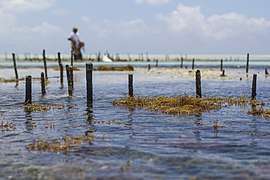 The seaweed grows underwater for 45 days. When it reaches one kilogram, the women pick it and dry it, then pack it in bags to be exported to countries like China, Korea and Vietnam. There, it's used in medicines and shampoos.
The seaweed grows underwater for 45 days. When it reaches one kilogram, the women pick it and dry it, then pack it in bags to be exported to countries like China, Korea and Vietnam. There, it's used in medicines and shampoos. The farmers have a lot of problems due to climate change. Two decades ago, 450 seaweed farmers roamed Paje. Now, only about 150 farmers remain.
The farmers have a lot of problems due to climate change. Two decades ago, 450 seaweed farmers roamed Paje. Now, only about 150 farmers remain.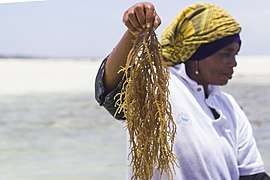 Mwanaisha holds up a healthy clump of seaweed. Then she holds up seaweed the farmers won't be able to use. A hard white substance grows on it - ice-ice disease, caused by higher ocean temperatures and intense sunlight.
Mwanaisha holds up a healthy clump of seaweed. Then she holds up seaweed the farmers won't be able to use. A hard white substance grows on it - ice-ice disease, caused by higher ocean temperatures and intense sunlight.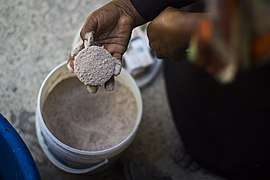 The seaweed farmers learned how to make soap from their seaweed at the Zanzibar Seaweed Center, a business that started as an NGO in 2009. At their homes, they mix water, ground seaweed powder, coconut oil, caustic soda and essential oils in a large plastic tub.
The seaweed farmers learned how to make soap from their seaweed at the Zanzibar Seaweed Center, a business that started as an NGO in 2009. At their homes, they mix water, ground seaweed powder, coconut oil, caustic soda and essential oils in a large plastic tub.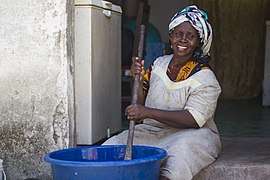 Later in the week, the seaweed farmers will sell their finished soaps in Zanzibar town or to regular local customers. As seaweed levels decline, they have found a way to increase the value of their work.
Later in the week, the seaweed farmers will sell their finished soaps in Zanzibar town or to regular local customers. As seaweed levels decline, they have found a way to increase the value of their work.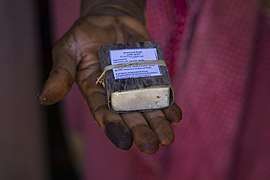 The finished product - a bar of seaweed soap.
The finished product - a bar of seaweed soap.
Uses
Farmed seaweed is used in a number of different industrially produced products, directly as food, and as source materials for things like biofuels.
Chemicals
Many seaweeds are used to produced derivative chemicals that can be used for various industrial, pharmaceutical or food products. Two major derivitative products are Carrageenan and Agar. However, there are a wide range of bioactive ingredients that can be used for a variety of industries, such as the pharmaceutical industry,[39] industrial food,[40] and the cosmetic industry.[41]
Carrageenan
Carrageenans or carrageenins (/ˌkærəˈɡiːnənz/ karr-ə-gee-nənz, from Irish carraigín, "little rock") are a family of linear sulfated polysaccharides that are extracted from red edible seaweeds. They are widely used in the food industry, for their gelling, thickening, and stabilizing properties. Their main application is in dairy and meat products, due to their strong binding to food proteins. There are three main varieties of carrageenan, which differ in their degree of sulfation. Kappa-carrageenan has one sulfate group per disaccharide, iota-carrageenan has two, and lambda-carrageenan has three.
Gelatinous extracts of the Chondrus crispus (Irish moss) seaweed have been used as food additives since approximately the fifteenth century.[42] Carrageenan is a vegetarian and vegan alternative to gelatin in some applications or may be used to replace gelatin in confectionery.Agar

Agar (/ˈeɪɡɑːr/ or /ˈɑːɡər/), or agar-agar, is a jelly-like substance, obtained from red algae.[43]
Agar is a mixture of two components: the linear polysaccharide agarose, and a heterogeneous mixture of smaller molecules called agaropectin.[44] It forms the supporting structure in the cell walls of certain species of algae, and is released on boiling. These algae are known as agarophytes, and belong to the Rhodophyta (red algae) phylum.[45][46]
Agar has been used as an ingredient in desserts throughout Asia, and also as a solid substrate to contain culture media for microbiological work. Agar can be used as a laxative, an appetite suppressant, a vegetarian substitute for gelatin, a thickener for soups, in fruit preserves, ice cream, and other desserts, as a clarifying agent in brewing, and for sizing paper and fabrics.[47]
The gelling agent in agar is an unbranched polysaccharide obtained from the cell walls of some species of red algae, primarily from tengusa (Gelidiaceae) and ogonori (Gracilaria). For commercial purposes, it is derived primarily from ogonori.[48] In chemical terms, agar is a polymer made up of subunits of the sugar galactose.Food
.jpg)
Edible seaweed, or sea vegetables, are seaweeds that can be eaten and used in the preparation of food. They typically contain high amounts of fiber.[49][50] They may belong to one of several groups of multicellular algae: the red algae, green algae, and brown algae.[49]
Seaweeds are also harvested or cultivated for the extraction of polysaccharides [51] such as alginate, agar and carrageenan, gelatinous substances collectively known as hydrocolloids or phycocolloids. Hydrocolloids have attained commercial significance, especially in food production as food additives.[52] The food industry exploits the gelling, water-retention, emulsifying and other physical properties of these hydrocolloids.[53]
Most edible seaweeds are marine algae whereas most freshwater algae are toxic. Some marine algae contain acids that irritate the digestion canal, while some others can have a laxative and electrolyte-balancing effect.[54] Most marine macroalgae are nontoxic in normal quantities, but members of the genus Lyngbya are potentially lethal.[55] Typically poisoning is caused by eating fish which have fed on Lyngbya or on other fish which have done so.[55] This is called ciguatura poisoning.[55] Handling Lyngbya majuscula can also cause seaweed dermatitis.[56] Some species of Desmarestia are highly acidic, with vacuoles of sulfuric acid that can cause severe gastrointestinal problems.[55]
The dish often served in western Chinese restaurants as 'Crispy Seaweed' is not seaweed but cabbage that has been dried and then fried.[57]Fuel
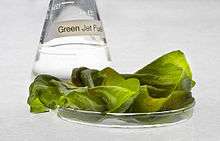
Algae fuel, algal biofuel, or algal oil is an alternative to liquid fossil fuels that uses algae as its source of energy-rich oils. Also, algae fuels are an alternative to commonly known biofuel sources, such as corn and sugarcane.[58][59] When made from seaweed (macroalgae) it can be known as seaweed fuel or seaweed oil.
Several companies and government agencies are funding efforts to reduce capital and operating costs and make algae fuel production commercially viable.[60][61] Like fossil fuel, algae fuel releases CO
2 when burnt, but unlike fossil fuel, algae fuel and other biofuels only release CO
2 recently removed from the atmosphere via photosynthesis as the algae or plant grew. The energy crisis and the world food crisis have ignited interest in algaculture (farming algae) for making biodiesel and other biofuels using land unsuitable for agriculture. Among algal fuels' attractive characteristics are that they can be grown with minimal impact on fresh water resources,[62][63] can be produced using saline and wastewater, have a high flash point,[64] and are biodegradable and relatively harmless to the environment if spilled.[65][66] Algae cost more per unit mass than other second-generation biofuel crops due to high capital and operating costs,[67] but are claimed to yield between 10 and 100 times more fuel per unit area.[68] The United States Department of Energy estimates that if algae fuel replaced all the petroleum fuel in the United States, it would require 15,000 square miles (39,000 km2), which is only 0.42% of the U.S. map,[69] or about half of the land area of Maine. This is less than 1⁄7 the area of corn harvested in the United States in 2000.[70]
See also
References
- Borgese 1980, p. 111.
- Borgese 1980, p. 112.
- Borgese 1980, p. 116.
- Ask 1999, p. 52.
- In brief, The State of World Fisheries and Aquaculture, 2018 (PDF). FAO. 2018.
- Duarte, Carlos M.; Wu, Jiaping; Xiao, Xi; Bruhn, Annette; Krause-Jensen, Dorte (2017). "Can Seaweed Farming Play a Role in Climate Change Mitigation and Adaptation?". Frontiers in Marine Science. 4. doi:10.3389/fmars.2017.00100. ISSN 2296-7745.
- Bindoff, N. L.; Cheung, W. W. L.; Kairo, J. G.; Arístegui, J.; et al. (2019). "Chapter 5: Changing Ocean, Marine Ecosystems, and Dependent Communities" (PDF). IPCC SROCC 2019. pp. 447–587.
- Yi, Haeng (1530) [1481]. Sinjeung Dongguk Yeoji Seungnam 신증동국여지승람(新增東國輿地勝覽) [Revised and Augmented Survey of the Geography of Korea] (in Literary Chinese). Joseon Korea.
- Ha, Yeon; Geum, Yu; Gim, Bin (1425). Gyeongsang-do Jiriji 경상도지리지(慶尙道地理志) [Geography of Gyeongsang Province] (in Korean). Joseon Korea.
- Naylor 1967, p. 73.
- Zertruche-Gonzalez 1997, p. 54.
- Maher-Johnson, Ayana Elizabeth Johnson,Louise Elizabeth. "Soil and Seaweed: Farming Our Way to a Climate Solution". Scientific American Blog Network. Retrieved 2020-05-07.
- "Vertical ocean farms that can feed us and help our seas". ideas.ted.com. 2017-07-26. Retrieved 2020-05-07.
- Crawford 2002, p. 2.
- Pollnac & et al 1997a, p. 67.
- Pollnac & et al 1997b, p. 79.
- Lucas, John S; Southgate, Paul C, eds. (2012). Aquaculture: Farming Aquatic Animals and Plants. Lucas, John S., 1940-, Southgate, Paul C. (2nd ed.). Chichester, West Sussex: Blackwell Publishing. p. 276. ISBN 978-1-4443-4710-4. OCLC 778436274.
- Flannery, Tim (2017). Sunlight and Seaweed: An Argument for How to Feed, Power and Clean Up the World. Melbourne, Victoria: The Text Publishing Company. ISBN 9781925498684.
- Flannery, Tim (July 2019). "Can Seaweed Help Curb Global Warming". TED.
- "Can Seaweed Save the World". ABC Australia. August 2017.
- Hawken, Paul (2017). Drawdown: the Most Comprehensive Plan Ever Proposed to Reverse Global Warming. New York, New York: Penguin Random House. pp. 178–180. ISBN 9780143130444.
- Gameau, Damon (Director) (May 23, 2019). 2040 (Motion picture). Australia: Good Things Productions.
- Von Herzen, Brian (June 2019). "Reverse Climate Change with Marine Permaculture Strategies for Ocean Regeneration". Youtube.
- Powers, Matt. "Marine Permaculture with Brian Von Herzen Episode 113 A Regenerative Future". Youtube.
- "Marine Permaculture with Dr Brian von Herzen & Morag Gamble". Youtube. December 2019.
- "Climate Foundation: Marine Permaculture". Climate Foundation. Retrieved 2020-07-05.
- "Climate Foundation: Marine Permaculture". Climate Foundation. Retrieved 2020-07-05.
- "Assessing the Potential for Restoration and Permaculture of Tasmania's Giant Kelp Forests - Institute for Marine and Antarctic Studies". Institute for Marine and Antarctic Studies - University of Tasmania, Australia. Retrieved 2020-07-05.
- Zertruche-Gonzalez 1997, p. 53.
- NOAA. "Nutrient Bioextraction Overview". Long Island Sound Study.
- Queirós, Ana Moura; Stephens, Nicholas; Widdicombe, Stephen; Tait, Karen; McCoy, Sophie J.; Ingels, Jeroen; Rühl, Saskia; Airs, Ruth; Beesley, Amanda; Carnovale, Giorgia; Cazenave, Pierre (2019). "Connected macroalgal-sediment systems: blue carbon and food webs in the deep coastal ocean". Ecological Monographs. 89 (3): e01366. doi:10.1002/ecm.1366. ISSN 1557-7015.
- Wernberg, Thomas; Filbee-Dexter, Karen (December 2018). "Grazers extend blue carbon transfer by slowing sinking speeds of kelp detritus". Scientific Reports. 8 (1): 17180. Bibcode:2018NatSR...817180W. doi:10.1038/s41598-018-34721-z. ISSN 2045-2322. PMC 6249265. PMID 30464260.
- Krause-Jensen, Dorte; Lavery, Paul; Serrano, Oscar; Marbà, Núria; Masque, Pere; Duarte, Carlos M. (2018-06-30). "Sequestration of macroalgal carbon: the elephant in the Blue Carbon room". Biology Letters. 14 (6): 20180236. doi:10.1098/rsbl.2018.0236. PMC 6030603. PMID 29925564.
- Schiel, David R. The biology and ecology of giant kelp forests. Foster, Michael S. Oakland, California. ISBN 978-0-520-96109-8. OCLC 906925033.
- N‘Yeurt, Antoine de Ramon; Chynoweth, David P.; Capron, Mark E.; Stewart, Jim R.; Hasan, Mohammed A. (2012-11-01). "Negative carbon via Ocean Afforestation". Process Safety and Environmental Protection. Special Issue: Negative emissions technology. 90 (6): 467–474. doi:10.1016/j.psep.2012.10.008. ISSN 0957-5820.
- Trono 1990, p. 4.
- "Evolution of Seaweed Farming in Tanzania: Achievements and Challenges Associated with Climate Change | The Ocean Policy Research Institute-OceanNewsletter". THE SASAKAWA PEACE FOUNDATION. Retrieved 2020-05-06.
- "Seaweed farming in Zanzibar". BBC News. Retrieved 2020-05-06.
- Siahaan, Evi Amelia; Pangestuti, Ratih; Kim, Se-Kwon (2018), Rampelotto, Pabulo H.; Trincone, Antonio (eds.), "Seaweeds: Valuable Ingredients for the Pharmaceutical Industries", Grand Challenges in Marine Biotechnology, Grand Challenges in Biology and Biotechnology, Springer International Publishing, pp. 49–95, doi:10.1007/978-3-319-69075-9_2, ISBN 978-3-319-69075-9
- "Seaweed.ie :: Seaweed e-numbers". www.seaweed.ie. Retrieved 2020-05-07.
- Couteau, C.; Coiffard, L. (2016-01-01), Fleurence, Joël; Levine, Ira (eds.), "Chapter 14 - Seaweed Application in Cosmetics", Seaweed in Health and Disease Prevention, Academic Press, pp. 423–441, ISBN 978-0-12-802772-1, retrieved 2020-05-07
- FAO Agar and Carrageenan Manual. Fao.org (1965-01-01). Retrieved on 2011-12-10.
- Oxford Dictionary of English (2 ed.). 2005.
- Williams, Peter W.; Phillips, Glyn O. Agar is made from seaweed and it is attracted to bacteria. (2000). "Chapter 2: Agar". Handbook of hydrocolloids. Cambridge: Woodhead. p. 91. ISBN 1-85573-501-6.
- Edward Balfour (1871). Cyclopædia of India and of eastern and southern Asia, commercial, industrial and scientific: products of the mineral, vegetable and animal kingdoms, useful arts and manufactures. Scottish and Adelphi Presses. p. 50.
agar.
- Alan Davidson (2006). The Oxford Companion to Food. Oxford University Press. ISBN 978-0-19-280681-9.
- Edward Green Balfour (1857). Cyclopaedia of India and of Eastern and Southern Asia, commercial, industrial and scientific... printed at the Scottish Press. p. 13.
- Shimamura, Natsu (August 4, 2010). "Agar". The Tokyo Foundation. Retrieved 19 December 2016.
- Garcia-Vaquero, M; Hayes, M (2016). "Red and green macroalgae for fish and animal feed and human functional food development". Food Reviews International. 32: 15–45. doi:10.1080/87559129.2015.1041184.
- K.H. Wong, Peter C.K. Cheung (2000). "Nutritional evaluation of some subtropical red and green seaweeds: Part I — proximate composition, amino acid profiles and some physico-chemical properties". Food Chemistry. 71 (4): 475–482. doi:10.1016/S0308-8146(00)00175-8.
- Garcia-Vaquero, M; Rajauria, G; O'Doherty, J.V; Sweeney, T (2017-09-01). "Polysaccharides from macroalgae: Recent advances, innovative technologies and challenges in extraction and purification". Food Research International. 99 (Pt 3): 1011–1020. doi:10.1016/j.foodres.2016.11.016. hdl:10197/8191. ISSN 0963-9969. PMID 28865611.
- Round F.E. 1962 The Biology of the Algae. Edward Arnold Ltd.
- Garcia-Vaquero, M; Lopez-Alonso, M; Hayes, M (2017-09-01). "Assessment of the functional properties of protein extracted from the brown seaweed Himanthalia elongata (Linnaeus) S. F. Gray". Food Research International. 99 (Pt 3): 971–978. doi:10.1016/j.foodres.2016.06.023. hdl:10197/8228. ISSN 0963-9969. PMID 28865623.
- Wiseman, John SAS Survival Handbook
- Turner, Nancy J.; von Aderkas, Patrick (2009). "3: Poisonous Plants of Wild Areas". The North American Guide to Common Poisonous Plants and Mushrooms. Portland, OR: Timber Press. pp. 115–6. ISBN 9780881929294. OCLC 747112294.
- James, William D.; Berger, Timothy G.; et al. (2006). Andrews' Diseases of the Skin: clinical Dermatology. Saunders Elsevier. ISBN 978-0-7216-2921-6.
- Hom, Ken (2012). "Crisp Seeweed". Good Food Channel. UK TV.CO.UK. Retrieved 16 October 2014.
- Scott, S. A.; Davey, M. P.; Dennis, J. S.; Horst, I.; Howe, C. J.; Lea-Smith, D. J.; Smith, A. G. (2010). "Biodiesel from algae: Challenges and prospects". Current Opinion in Biotechnology. 21 (3): 277–286. doi:10.1016/j.copbio.2010.03.005. PMID 20399634.
- Darzins, Al; Pienkos, Philip; Edye, Les (2010). Current status and potential for algal biofuels production (PDF). IEA Bioenergy Task 39.
- Oncel, S. S. (2013). "Microalgae for a macroenergy world". Renewable and Sustainable Energy Reviews. 26: 241–264. doi:10.1016/j.rser.2013.05.059.
- Could Our Energy Come from Giant Seaweed Farms in the Ocean?
- Yang, Jia; Xu, Ming; Zhang, Xuezhi; Hu, Qiang; Sommerfeld, Milton; Chen, YongShen (2010). "Life-cycle analysis on biodiesel production from microalgae: Water footprint and nutrients balance" (PDF). Bioresource Technology. 10 (1): 159–65. doi:10.1016/j.biortech.2010.07.017. PMID 20675125. Archived from the original (PDF) on 27 February 2012.
- Cornell, Clayton B. (29 March 2008). "First Algae Biodiesel Plant Goes Online: 1 April 2008". Gas 2.0. Retrieved 10 June 2008.
- Dinh, L. T. T.; Guo, Y.; Mannan, M. S. (2009). "Sustainability evaluation of biodiesel production using multicriteria decision-making". Environmental Progress & Sustainable Energy. 28: 38–46. doi:10.1002/ep.10335.
- Demirbas, A. (2011). "Biodiesel from oilgae, biofixation of carbon dioxide by microalgae: A solution to pollution problems". Applied Energy. 88 (10): 3541–3547. doi:10.1016/j.apenergy.2010.12.050.
- Demirbas, AH (2009). "Inexpensive oil and fats feedstocks for production of biodiesel". Energy Education Science and Technology Part A: Energy Science and Research. 23: 1–13.
- Carriquiry, M. A.; Du, X.; Timilsina, G. R. (2011). "Second generation biofuels: Economics and policies" (PDF). Energy Policy. 39 (7): 4222–4234. doi:10.1016/j.enpol.2011.04.036. hdl:10986/3891.
- Greenwell, H. C.; Laurens, L. M. L.; Shields, R. J.; Lovitt, R. W.; Flynn, K. J. (2009). "Placing microalgae on the biofuels priority list: A review of the technological challenges". Journal of the Royal Society Interface. 7 (46): 703–726. doi:10.1098/rsif.2009.0322. PMC 2874236. PMID 20031983.
- Hartman, Eviana (6 January 2008). "A Promising Oil Alternative: Algae Energy". The Washington Post. Retrieved 10 June 2008.
- Dyer, Gwynne (17 June 2008). "A replacement for oil". The Chatham Daily News. Archived from the original on 11 October 2008. Retrieved 18 June 2008.
- Feldman, Stacy (22 November 2010). "Algae Fuel Inches Toward Price Parity with Oil". Reuters. Retrieved 14 February 2011.
"We're hoping to be at parity with fossil fuel-based petroleum in the year 2017 or 2018, with the idea that we will be at several billions of gallons," Rosenthal told SolveClimate News in a phone interview.
- "Exxon at Least 25 Years Away From Making Fuel From Algae" Bloomberg, 8 March 2013
- "ExxonMobil and Synthetic Genomics report breakthrough in algae biofuel research". ExxonMobil.
- "CRISPR-edited algae with high biofuel yield created by ExxonMobil, Craig Venter's Synthetic Genomics". Genetic Literacy Project. 21 June 2017.
- Voegele, Erin (15 November 2012). "Propel, Solazyme make algae biofuel available to the public". Biomass Magazine.
- Herndon, Andrew (20 March 2013). "Tesoro is first customer for Sapphire's algae-derived crude oil". Bloomberg.
- "Algenol Announces Commercial Algal Ethanol Fuel Partnership". Energy.gov. Retrieved 2016-11-15.
- Wesoff, Eric (19 April 2017). "Hard Lessons From the Great Algae Biofuel Bubble". Retrieved 5 August 2017.
Sources
![]()
- Ask, E.I (1990). Cottonii and Spinosum Cultivation Handbook. FMC BioPolymer Corporation.Philippines.CS1 maint: ref=harv (link)
- Borgese, Elisabeth Mann (1980). Seafarm: the story of aquaculture. Harry N. Abrams, Incorporated, New York. ISBN 0-8109-1604-5.CS1 maint: ref=harv (link)
- Crawford, B.R (2002). Seaweed farming :An Alternative Livelihood for Small-Scale Fishers?. Proyek Pesisir Publication. University of Rhode Island, Coastal Resources Center, Narragansett, Rhode Island, USA.CS1 maint: ref=harv (link)
- Naylor, J (1976). Production, trade and utilization of seaweeds and seaweed products. FAO Fisheries Technical Paper No. 159. Food and Agriculture Organization of the United Nations. Rome.CS1 maint: ref=harv (link)
- Pollnac, R.B; et al. (1997a). Rapid Assessment of Coastal Management Issues on the Coast of Minahasa. Proyek Pesisir Technical Report No: TE-97/01-E. Coastal Resources Center, University of Rhode Island, Narragansett, Rhode Island, USA.CS1 maint: ref=harv (link)
- Pollnac, R.B; et al. (1997b). Baseline Assessment of Socioeconomic Aspects of Resources Use in the Coastal Zone of Bentenan and Tumbak. Proyek Pesisir Technical Report No: TE-97/01-E. Coastal Resources Center, University of Rhode Island, Narragansett, Rhode Island, USA.CS1 maint: ref=harv (link)
- Trono, G.C (1990). Seaweed resources in the developing countries of Asia: production and socioeconomic implications. Aquaculture Department,Southeast Asia Fisheries Development Center. Tigbauan, Iloilo, Philippines.CS1 maint: ref=harv (link)
- Zertruche-Gonzalez, Jose A. (1997). Coral Reefs: Challenges and Opportunities for Sustainable Management. The World Bank. ISBN 0-8213-4235-5.CS1 maint: ref=harv (link)
